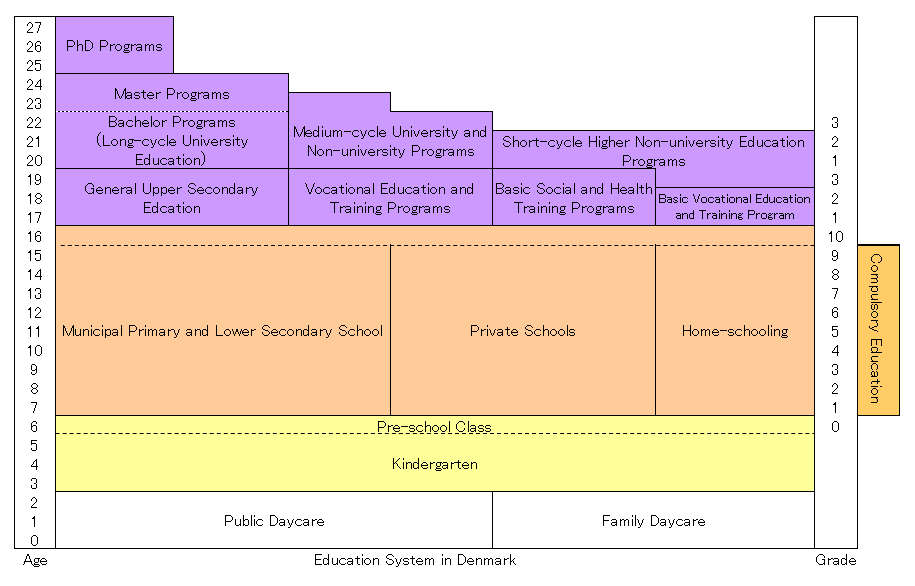
Reference:
http://www.ibe.unesco.org/en/worldwide/unesco-regions/europe-and-north-america/denmark/profile-of-education.html
http://pub.uvm.dk/2005/facts/kap02.html
Kanako KORENAGA, Ph.D
Associate professor
Kochi University Faculty of Education, Japan
Education System in Denmark
-
Daycare 1
Daycare consists of public daycare (vuggestue)and family daycare (dagpleje) in daycare workers provides daycare services at home. Both accept children between the ages of 6 months and 3 years, a period which corresponds to the end of maternity leave and the beginning of kindergarten. -
Kindergarten 2
Kindergarten (børnehave ) is for children from the age of 3 and to the start of elementary school (ages 6 or 7). Compulsory education begins at 7, but nearly all children at the age of 6 attend an optional year of pre-school class (b?nehaveklasse) prior to first grade. 3 -
Compulsory Education (Primary and Lower Secondary Education) 4
Compulsory education (primary and lower secondary education) is provided at municipal primary and lower secondary school (folkeskole), private schools (friskole), and by home-schooling (hjemmeundervisning). Compulsory education is a period of nine years from the age of 7 to 16, with the option of attending school for a tenth year. In 2002/2003, 61% of children attended the tenth year, which is subsidized by the government and used as a time to consider future plans. 5 -
Upper Secondary Education 6
There are two basic tracks. First, general upper secondary education is provided at the gymnasium. The gymnasium offers three-year curricula that qualify students in three programs: STX (almene gymnasium) for completion of upper secondary education as preparation for higher education, HHX (handelsgymnasium) or the higher commercial examination program, and HTX (teknisk gymnasium) or the higher technical examination program. The HF (2-årig h?ere forberedelseseksamen) is an additional two-year upper secondary education program that prepares students who have completed the tenth year them for the HF examination.Second, as vocational or technical education, there are programs for vocational education and training (VET) or basic social and health training. The VET programs require from 1.5 to 5 years of study, averaging 3 to 3.5 years. The basic social and health training programs require 3 years of study for future work in education or daycare as social workers or teaching assistants, etc. 7
Both of the above are considered tracks to higher education.
In addition to the above, Basic Vocational Education and Training (EGU), which does not aim to prepare students for higher education, is a period of 1.5 to 3 years, and production schools offer one-year programs to develop vocational competence, targeting people under 25 who have not completed adequate education. Students at production school train for an average of five months, but 15% complete training after one month and 30% after six months. 8
-
Higher Education 9
Short-cycle higher non-university programs are 2-3 years and offered at institutions of higher education other than universities. 10 Medium-cycle university and non-university programs for 3-4 years 11 are offered at both university and non-university institutions. Non-university institutions of higher education include professionally-oriented colleges that train teachers, nurses, journalists, artists, musicians, librarians, and other professional occupations. Long-cycle university programs, which are minimum of three years, confer an academic degree. The time required depends on the particular course of study, with 3 years for a bachelor’s degree, 2 years for a master’s degree, and at least 3 years for a doctoral degree. 12Denmark’s education system also provides a range of social and adult education. Continuation schools (efterskole) provide education for 1 to 3 years from grades 8, 9, and 10 to young people between the ages of 14 and 17. Youth schools (ungdomsskole) offer education for 2 to 3 years, after completion of compulsory education or from the ages of 16 to 19 after finishing a continuation school.
Folk High Schools (folkeh?skole) provide continuing education to all at no charge. 13
Sources:
1. Takada-Keller, Yuko, Tairana kuni denmaaku (Tokyo: Nippon Hoso Shuppan Kyokai, 2005) 54.
2. Pre-Primary Education, Danish Ministry of Education. http://www.eng.uvm.dk/Uddannelse/Pre-Primary%20Education.aspx (January 5, 2010).
3. http://pub.uvm.dk/2005/facts/kap02.html (January 5, 2010).
4. Folkeskole, http://www.eng.uvm.dk/~/media/Files/English/Fact%20sheets/080101_fact_sheet_the_folkeskole.ashx (January 5, 2010).
5. Facts and Figures 2005, Danish Ministry of Education. http://pub.uvm.dk/2005/facts/kap02.html (January 5, 2010).
6. Upper Secondary Education, Fact Sheet, Danish Ministry of Education. http://www.eng.uvm.dk/Fact%20Sheets/Upper%20secondary%20education.aspx (January 5, 2010).
7. Facts and Figures 2005, Danish Ministry of Education. http://pub.uvm.dk/2005/facts/kap02.html (January 5, 2010).
8. Ibid.
9. Higher Education, Fact Sheets, Danish Ministry of Education. http://www.eng.uvm.dk/Fact%20Sheets/Higher%20education.aspx (January 5, 2010).
10. Facts and Figures 2005, Danish Ministry of Education. http://pub.uvm.dk/2005/facts/kap02.html (January 5, 2010).
11. Ibid.
12. Ibid.
13. Adult Vocational Training in Denmark, Danish Ministry of Education. http://www.eng.uvm.dk/~/media/Files/English/Fact%20sheets/080101_fact_sheet_adult_education.ashx (January 5, 2010).
Bibliography
Nomura, Takeo. Nomaraizeshon ga umareta kuni denmaaku. Kyoto: Minerva Shobo, 2004.
Brandt, Sawado Natsuyo Denmaaku no kosodate hitosodachi. Tokyo: Otsuki Shoten, 2005.